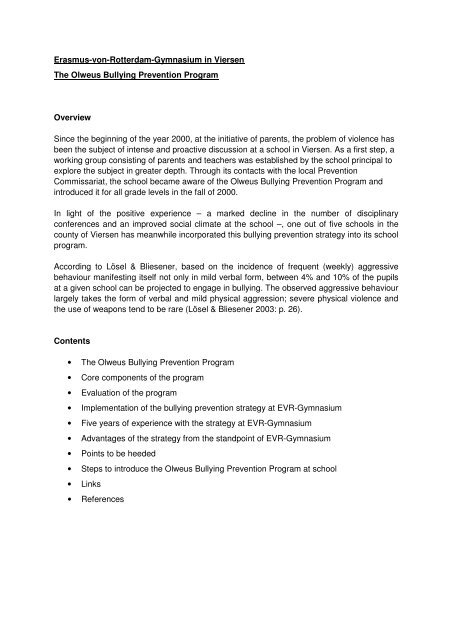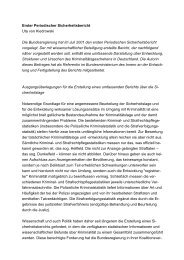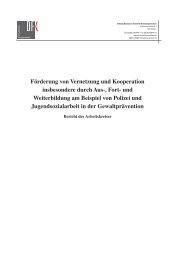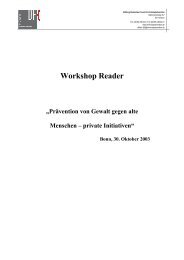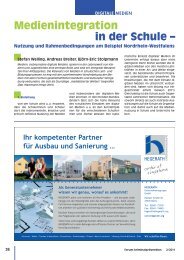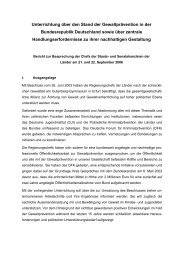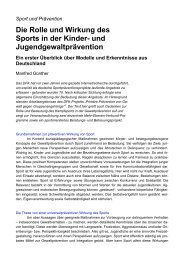Erasmus-von-Rotterdam-Gymnasium in Viersen The Olweus ...
Erasmus-von-Rotterdam-Gymnasium in Viersen The Olweus ...
Erasmus-von-Rotterdam-Gymnasium in Viersen The Olweus ...
You also want an ePaper? Increase the reach of your titles
YUMPU automatically turns print PDFs into web optimized ePapers that Google loves.
<strong>Erasmus</strong>-<strong>von</strong>-<strong>Rotterdam</strong>-<strong>Gymnasium</strong> <strong>in</strong> <strong>Viersen</strong><br />
<strong>The</strong> <strong>Olweus</strong> Bully<strong>in</strong>g Prevention Program<br />
Overview<br />
S<strong>in</strong>ce the beg<strong>in</strong>n<strong>in</strong>g of the year 2000, at the <strong>in</strong>itiative of parents, the problem of violence has<br />
been the subject of <strong>in</strong>tense and proactive discussion at a school <strong>in</strong> <strong>Viersen</strong>. As a first step, a<br />
work<strong>in</strong>g group consist<strong>in</strong>g of parents and teachers was established by the school pr<strong>in</strong>cipal to<br />
explore the subject <strong>in</strong> greater depth. Through its contacts with the local Prevention<br />
Commissariat, the school became aware of the <strong>Olweus</strong> Bully<strong>in</strong>g Prevention Program and<br />
<strong>in</strong>troduced it for all grade levels <strong>in</strong> the fall of 2000.<br />
In light of the positive experience – a marked decl<strong>in</strong>e <strong>in</strong> the number of discipl<strong>in</strong>ary<br />
conferences and an improved social climate at the school –, one out of five schools <strong>in</strong> the<br />
county of <strong>Viersen</strong> has meanwhile <strong>in</strong>corporated this bully<strong>in</strong>g prevention strategy <strong>in</strong>to its school<br />
program.<br />
Accord<strong>in</strong>g to Lösel & Bliesener, based on the <strong>in</strong>cidence of frequent (weekly) aggressive<br />
behaviour manifest<strong>in</strong>g itself not only <strong>in</strong> mild verbal form, between 4% and 10% of the pupils<br />
at a given school can be projected to engage <strong>in</strong> bully<strong>in</strong>g. <strong>The</strong> observed aggressive behaviour<br />
largely takes the form of verbal and mild physical aggression; severe physical violence and<br />
the use of weapons tend to be rare (Lösel & Bliesener 2003: p. 26).<br />
Contents<br />
• <strong>The</strong> <strong>Olweus</strong> Bully<strong>in</strong>g Prevention Program<br />
• Core components of the program<br />
• Evaluation of the program<br />
• Implementation of the bully<strong>in</strong>g prevention strategy at EVR-<strong>Gymnasium</strong><br />
• Five years of experience with the strategy at EVR-<strong>Gymnasium</strong><br />
• Advantages of the strategy from the standpo<strong>in</strong>t of EVR-<strong>Gymnasium</strong><br />
• Po<strong>in</strong>ts to be heeded<br />
• Steps to <strong>in</strong>troduce the <strong>Olweus</strong> Bully<strong>in</strong>g Prevention Program at school<br />
• L<strong>in</strong>ks<br />
• References
- 2 –<br />
<strong>The</strong> <strong>Olweus</strong> Bully<strong>in</strong>g Prevention Program<br />
In the 1980s, work<strong>in</strong>g on the basis of longitud<strong>in</strong>al studies, the Norwegian psychologist Dan<br />
<strong>Olweus</strong> developed a violence prevention and <strong>in</strong>tervention program for schools. <strong>The</strong> program<br />
facilitates the creation of conditions conducive to the reduction of direct and <strong>in</strong>direct forms of<br />
violence among pupils. As a result, these measures also improve the social climate at the<br />
school and solidarity among the pupils.<br />
Programs for the prevention of bully<strong>in</strong>g are directed aga<strong>in</strong>st so-called bullies. <strong>The</strong> term “bully”<br />
refers to persons who torment, mob or exhibit aggressive or violent behaviour towards<br />
others, put them under pressure, fleece them, etc.<br />
<strong>The</strong> program targets three levels: the schoolwide, classroom and <strong>in</strong>dividual levels. At each of<br />
these levels there are specific <strong>in</strong>tervention options. Examples at schoolwide level <strong>in</strong>clude<br />
cooperation between parents and teachers, closer supervision dur<strong>in</strong>g break periods or a<br />
hotl<strong>in</strong>e. At classroom level they can consist of classroom rules and consequences for<br />
<strong>in</strong>fractions as well as classroom meet<strong>in</strong>gs. Options at <strong>in</strong>dividual level <strong>in</strong>clude talks with the<br />
persons <strong>in</strong>volved. <strong>The</strong> aim is to <strong>in</strong>tervene at an early stage <strong>in</strong> order to prevent undesirable<br />
developments. Parents, pupils and teachers are all <strong>in</strong>volved.<br />
If a case of bully<strong>in</strong>g is reported, i.e. if a pupil feels threatened or attacked or if a parent or a<br />
teacher learns about an <strong>in</strong>cident, a procedure with which all are familiar can be activated.<br />
This starts a cha<strong>in</strong> of <strong>in</strong>terventions that make it possible to constructively address the act of<br />
aggression.<br />
Core components of the program<br />
• Determ<strong>in</strong>ation of whether teas<strong>in</strong>g or violence was <strong>in</strong>volved, whether the act <strong>in</strong> question<br />
was a joke that was carried too far or already a violation of an <strong>in</strong>dividual’s personal<br />
sphere, is not up to the perpetrator but rather to the victim. Attention is thus diverted<br />
away from the perpetrator, who has previously usually been the centre of attention, and is<br />
<strong>in</strong>stead focused on the victim. It is the victim who decides whether he/she feels mobbed,<br />
for example, not the perpetrator (“I was only kidd<strong>in</strong>g”). This very shift <strong>in</strong> perspective<br />
serves to strengthen the position of the victim.<br />
• If a case of bully<strong>in</strong>g occurs, the victimized pupil approaches a teacher <strong>in</strong> whom he/she<br />
has confidence, either directly or <strong>in</strong>directly through another pupil, or his/her parents<br />
approach such a teacher. <strong>The</strong> perpetrator is then called upon to state his/her view of the<br />
<strong>in</strong>cident <strong>in</strong> writ<strong>in</strong>g. <strong>The</strong> victim likewise describes the <strong>in</strong>cident <strong>in</strong> writ<strong>in</strong>g from his/her<br />
perspective. <strong>The</strong> teacher jots down a brief record of the <strong>in</strong>cident, <strong>in</strong>sofar as he/she was a<br />
witness thereto, add<strong>in</strong>g <strong>in</strong>formation from other witnesses if available. Thus the<br />
statements of all the pupils <strong>in</strong>volved are taken <strong>in</strong>to account, yield<strong>in</strong>g a differentiated<br />
picture of the facts of the case.<br />
• <strong>The</strong> various statements are then forwarded to the parents of the perpetrator, who are <strong>in</strong><br />
turn asked to respond. Not until afterwards is there a meet<strong>in</strong>g of the parties <strong>in</strong>volved or,<br />
depend<strong>in</strong>g on the severity of the <strong>in</strong>cident, a class conference.<br />
Aim of this procedure: By mak<strong>in</strong>g the <strong>in</strong>cident public, the perpetrator is to be deprived of<br />
the protection and <strong>in</strong>visibility he/she enjoys when others keep silent or look the other way.<br />
At the same time, the victim is given the certa<strong>in</strong>ty that subsequent <strong>in</strong>timidation attempts<br />
by the perpetrator will likewise immediately be made public.
- 3 –<br />
• Through these measures a victim can be confident that his/her “cry for help” will not only<br />
be heard but also prompt consistent and resolute action by the school. This <strong>in</strong>creas<strong>in</strong>gly<br />
encourages victims to speak up and thus defend themselves.<br />
Evaluation of the program<br />
Accord<strong>in</strong>g to Hanew<strong>in</strong>kel & Knaack, scientific evaluations of the program have been<br />
conducted <strong>in</strong>ter alia <strong>in</strong> the Scand<strong>in</strong>avian countries by <strong>Olweus</strong>, <strong>in</strong> the United K<strong>in</strong>gdom<br />
(Whitney & Smith 1993) and <strong>in</strong> Ch<strong>in</strong>a (Ekbald & <strong>Olweus</strong> 1986). In Germany the program was<br />
translated for <strong>in</strong>troduction <strong>in</strong> schools <strong>in</strong> Schleswig-Holste<strong>in</strong>, and a statewide evaluation was<br />
carried out (Hanew<strong>in</strong>kel & Knaack 1997) that orig<strong>in</strong>ally encompassed nearly 15,000 pupils at<br />
47 schools. Ten of these schools did not participate <strong>in</strong> the second survey. In the first survey,<br />
between 10% and 20% of the pupils stated that they had already been a victim of mobb<strong>in</strong>g at<br />
one time. <strong>The</strong> results of the evaluation can be summarized as follows:<br />
• Reduction of direct forms of mobb<strong>in</strong>g by as much as 7.5% up to grade 10.<br />
• Tangible and measurable improvement of the social climate at the school<br />
(determ<strong>in</strong>ed from questionnaires filled out by pupils, parents and teachers).<br />
• Improved cooperation among the faculty.<br />
• Organizational changes such as new rules for break periods and redesign of the area<br />
used dur<strong>in</strong>g break periods.<br />
<strong>The</strong> authors were unable to obta<strong>in</strong> any measurable results concern<strong>in</strong>g <strong>in</strong>direct forms of<br />
mobb<strong>in</strong>g (exclusion/isolation) and attitudes towards mobb<strong>in</strong>g (Hanew<strong>in</strong>kel & Knaack 1997).<br />
Implementation of the bully<strong>in</strong>g prevention strategy at <strong>Erasmus</strong>-<strong>von</strong>-<strong>Rotterdam</strong>-<br />
<strong>Gymnasium</strong><br />
• Parents receive <strong>in</strong>formation about <strong>Erasmus</strong>-<strong>von</strong>-<strong>Rotterdam</strong>-<strong>Gymnasium</strong> (EVR-<br />
<strong>Gymnasium</strong>) bully<strong>in</strong>g prevention strategy at the time they register their child for 5 th<br />
grade. Teachers and pupils sign an agreement to help prevent bully<strong>in</strong>g. <strong>The</strong> issue is<br />
addressed <strong>in</strong> depth dur<strong>in</strong>g classroom <strong>in</strong>struction <strong>in</strong> grade 5, and classroom rules are<br />
drawn up <strong>in</strong> cooperation with the pupils.<br />
• <strong>The</strong> strategy is aga<strong>in</strong> addressed <strong>in</strong> classroom <strong>in</strong>struction <strong>in</strong> grade 7. Pupils’<br />
knowledge of the issues associated with bully<strong>in</strong>g is refreshed and broadened to<br />
encompass crim<strong>in</strong>al aspects and crim<strong>in</strong>al responsibility. <strong>The</strong> Prevention<br />
Commissariat provides support <strong>in</strong> the form of <strong>in</strong>struction modules oriented towards<br />
particularly timely topics such as fleec<strong>in</strong>g or shoplift<strong>in</strong>g. <strong>The</strong> classroom rules are<br />
revised and adapted.<br />
• <strong>The</strong> school adm<strong>in</strong>istration approaches the student body representatives on a regular<br />
basis and thus obta<strong>in</strong>s feedback on the social climate at the school and possible<br />
irregularities. <strong>The</strong> pr<strong>in</strong>cipal expla<strong>in</strong>s that <strong>in</strong> the case of problems <strong>in</strong>volv<strong>in</strong>g a number<br />
of pupils, for example, a special event on the subject may also be held for a specific<br />
grade level.<br />
• Regular even<strong>in</strong>gs or conferences on the subject are scheduled for the faculty, and the<br />
bully<strong>in</strong>g prevention strategy is firmly entrenched <strong>in</strong> the school program.
- 4 –<br />
Five years of experience with the strategy at EVR-<strong>Gymnasium</strong><br />
With just a very few exceptions, experience with the EVR-<strong>Gymnasium</strong> bully<strong>in</strong>g prevention<br />
strategy has been overwhelm<strong>in</strong>gly positive. <strong>The</strong> social climate at the school has improved.<br />
<strong>The</strong> number of discipl<strong>in</strong>ary conferences has decl<strong>in</strong>ed markedly, from 5 – 6 per year <strong>in</strong> the<br />
years 1990 – 2001 to an average of one per year today. In the course of implementation,<br />
however, it has become clear that this strategy is not the panacea for every situation and<br />
should not be used <strong>in</strong> m<strong>in</strong>or cases because it otherwise tends to lose its effectiveness. In<br />
each case that is reported, a decision is made as to whether the bully<strong>in</strong>g prevention strategy<br />
or another option such as the mediation program is more appropriate.<br />
Experience at the school has shown that the very knowledge of this comprehensive and<br />
transparent procedure prompts many pupils, especially younger ones, to clearly distance<br />
themselves from bully<strong>in</strong>g and violence.<br />
Some criticism has been voiced <strong>in</strong> regard to the amount of writ<strong>in</strong>g <strong>in</strong>volved. In view of the<br />
central importance of writ<strong>in</strong>g for the strategy, however, this cannot be avoided. Assistance is<br />
offered to parties who have difficulty express<strong>in</strong>g themselves <strong>in</strong> writ<strong>in</strong>g.<br />
<strong>The</strong> police crime statistics for the county of <strong>Viersen</strong> show that the number of violent offences<br />
reported to the police decl<strong>in</strong>ed 20% <strong>in</strong> the year 2003. 57% of all violent offences <strong>in</strong> the<br />
county of <strong>Viersen</strong> are committed by school-age young people (see Devries 2004).<br />
Advantages of the strategy from the standpo<strong>in</strong>t of EVR-<strong>Gymnasium</strong><br />
• <strong>The</strong> written form of expression more strongly encourages pupils to th<strong>in</strong>k seriously<br />
about their behaviour.<br />
• Description of the <strong>in</strong>cident <strong>in</strong> writ<strong>in</strong>g fosters greater objectivity and an ability to view<br />
events from a distance.<br />
• Each of the parties <strong>in</strong>volved can present his/her po<strong>in</strong>t of view without <strong>in</strong>terruption or<br />
<strong>in</strong>fluence.<br />
• Through the written form of expression, the school learns considerably more about<br />
the background and circumstances of the <strong>in</strong>cident.<br />
• Dur<strong>in</strong>g the subsequent or f<strong>in</strong>al meet<strong>in</strong>g, the parties <strong>in</strong>volved must look each other <strong>in</strong><br />
the eye and either endure this tension or dispel it through reconciliation.<br />
• In the event of a recurrence, a written record already exists to which discipl<strong>in</strong>ary<br />
measures can directly refer.<br />
• Parents are also expected to shoulder responsibility and are above all <strong>in</strong>formed.
- 5 –<br />
Po<strong>in</strong>ts to be heeded<br />
• <strong>The</strong> <strong>Olweus</strong> Bully<strong>in</strong>g Prevention Program reaches the limits of its usefulness <strong>in</strong><br />
particularly difficult cases, for example when there is also violence <strong>in</strong> the family or<br />
when a behavioural disorder such as pathological aggression is established.<br />
• In such cases it has become apparent that a comb<strong>in</strong>ation of several types of<br />
responses can prove successful, such as implementation of the <strong>Olweus</strong> Bully<strong>in</strong>g<br />
Prevention Program and a commitment to participate <strong>in</strong> an assertiveness tra<strong>in</strong><strong>in</strong>g<br />
program.<br />
• Effectiveness is compromised if parental support is lack<strong>in</strong>g or denied.<br />
• <strong>The</strong>re is a risk that teachers will cease to speak directly with pupils because they<br />
believe that the problem has been resolved once and for all by sett<strong>in</strong>g everyth<strong>in</strong>g out<br />
<strong>in</strong> writ<strong>in</strong>g.<br />
• <strong>The</strong>re is a risk that pupils will apologize too readily and unconv<strong>in</strong>c<strong>in</strong>gly, swear<strong>in</strong>g to<br />
“never do it aga<strong>in</strong>” without demonstrat<strong>in</strong>g a correspond<strong>in</strong>g sense of wrongdo<strong>in</strong>g.<br />
• <strong>The</strong> <strong>Olweus</strong> Bully<strong>in</strong>g Prevention Program should not be implemented mechanically<br />
because there is otherwise a risk that it may be seen as an end <strong>in</strong> itself and that the<br />
effectiveness of this <strong>in</strong>strument may be dulled (“Oh no, here they go aga<strong>in</strong>!”).<br />
Steps to <strong>in</strong>troduce the <strong>Olweus</strong> Bully<strong>in</strong>g Prevention Program at school<br />
1. Creation of a common awareness of the problem.<br />
2. Circulation of a questionnaire to ascerta<strong>in</strong> the current <strong>in</strong>cidence of aggressive behaviour<br />
and violence at the school; the precise content should be jo<strong>in</strong>tly developed and agreed<br />
by teachers, parents and pupils.<br />
3. Presentation of the <strong>Olweus</strong> Bully<strong>in</strong>g Prevention Program and the results of the survey at<br />
a teachers’ meet<strong>in</strong>g.<br />
4. Organization of a parents’ even<strong>in</strong>g on the subject.<br />
5. Decision by the school conference to <strong>in</strong>troduce the program.<br />
6. Incorporation <strong>in</strong>to the school program.<br />
7. Involvement of the pupils through written agreements.<br />
8. Publicity <strong>in</strong> the school newspaper, <strong>in</strong> the press or at an <strong>in</strong>formational even<strong>in</strong>g for parents<br />
register<strong>in</strong>g children for 5 th grade, for example.
- 6 –<br />
L<strong>in</strong>ks<br />
<strong>Olweus</strong> Bully<strong>in</strong>g Prevention Program:<br />
http://about.preventiondss.org/html/documents/select_programs/sa/Bully<strong>in</strong>gPrevention.htm<br />
OECD, International Network on School Bully<strong>in</strong>g and Violence:<br />
http://oecd-sbv.net/Templates/Article.aspxid=353<br />
Deutsches Forum für Krim<strong>in</strong>alprävention, Primäre Prävention <strong>von</strong> Gewalt gegen<br />
Gruppenangehörige - <strong>in</strong>sbesondere: junge Menschen. E<strong>in</strong>führung und Empfehlungen der<br />
Arbeitsgruppe. Kurzfassung. Empfehlung 5.<br />
http://www.krim<strong>in</strong>alpraevention.de/service.htm<br />
References<br />
Devries, Y<strong>von</strong>ne (2004). Jugendkrim<strong>in</strong>alität. Gewalt <strong>in</strong> Schulen. Unveröffentlichte<br />
Vordiplomarbeit, Studiengang Sozialwesen an der Fachhochschule Fulda.<br />
Hanew<strong>in</strong>kel, R. & Knaack, R. (1997). Mobb<strong>in</strong>g: Gewaltprävention <strong>in</strong> Schulen <strong>in</strong> Schleswig-<br />
Holste<strong>in</strong>. Kiel: Landes<strong>in</strong>stitut für <strong>The</strong>orie und Praxis <strong>in</strong> der Schule (IPTS). Nr. 11503/97.<br />
Lösel, F. & Bliesener, T. (2003). Aggression und Del<strong>in</strong>quenz unter Jugendlichen.<br />
Bundeskrim<strong>in</strong>alamt (BKA). Polizei + Forschung. Bd. 20. Luchterhand.<br />
<strong>Olweus</strong>, D. (1991). Bully/victim problems among schoolchildren: Basic facts and effects of a<br />
school-based <strong>in</strong>tervention program. In D.J. Pepler & K.H. Rub<strong>in</strong> (Eds.), <strong>The</strong> development<br />
and treatment of childhood aggression (pp. 411-448). Hillsdale, NJ: Lawrence Erlbaum.<br />
(wiedergegeben nach Hanew<strong>in</strong>kel, R. & Knaack, R. [1997]).<br />
<strong>Olweus</strong>, D. (1993). Bully<strong>in</strong>g at School: What We Know and What We Can Do. Oxford, UK:<br />
Blackwell.<br />
<strong>Olweus</strong>, D. (1995). Gewalt <strong>in</strong> der Schule. Was Lehrer und Eltern wissen sollten – und tun<br />
können. Bern: Huber.<br />
Stoffel, Wolfgang (2005). Unveröffentlichte Unterlagen zum Anti-Bully<strong>in</strong>g Projekt am EVR.<br />
For further <strong>in</strong>formation (<strong>in</strong> German): evr-schulleitung@t-onl<strong>in</strong>e.de<br />
www.regionaldienst.nrw.de, (12 December 2004, Devries, Y.)<br />
Zöllner, Hermann & Kahn, Ulrike. H<strong>in</strong>weise, Anregungen und Vorschläge für die<br />
Pädagogische Arbeit. PLIB.<br />
http://www.lisum.brandenburg.de/rechtsextremismus/konzepte/6_h<strong>in</strong>weise.htm<br />
(19 January 2006)


